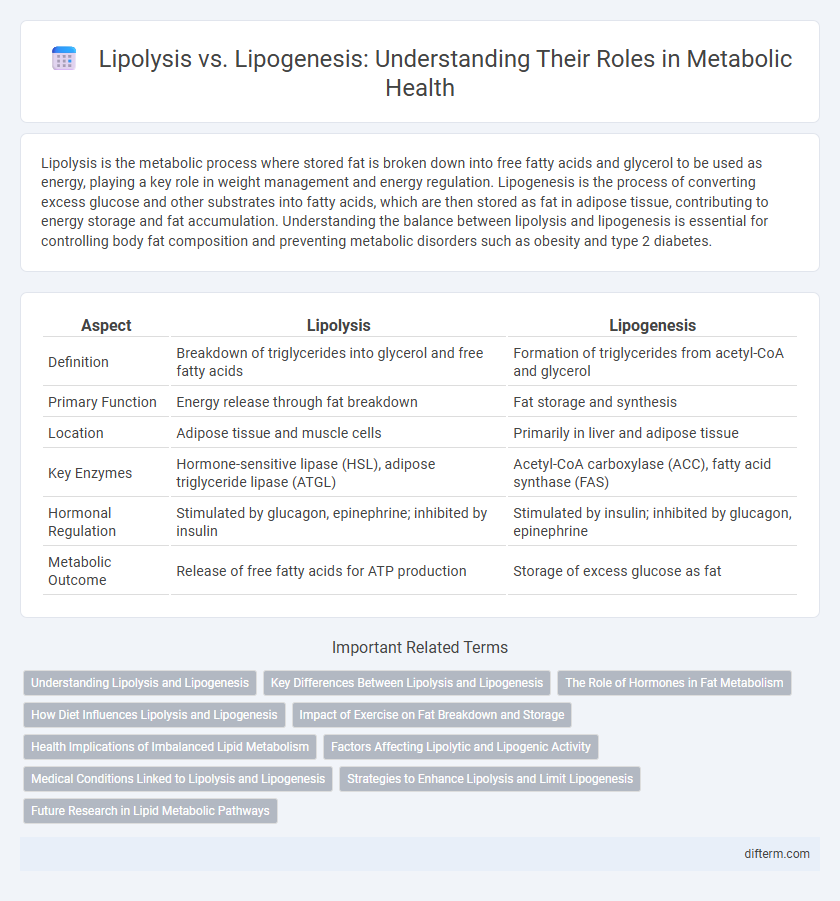Lipolysis is the metabolic process where stored fat is broken down into free fatty acids and glycerol to be used as energy, playing a key role in weight management and energy regulation. Lipogenesis is the process of converting excess glucose and other substrates into fatty acids, which are then stored as fat in adipose tissue, contributing to energy storage and fat accumulation. Understanding the balance between lipolysis and lipogenesis is essential for controlling body fat composition and preventing metabolic disorders such as obesity and type 2 diabetes.
Table of Comparison
| Aspect | Lipolysis | Lipogenesis |
|---|---|---|
| Definition | Breakdown of triglycerides into glycerol and free fatty acids | Formation of triglycerides from acetyl-CoA and glycerol |
| Primary Function | Energy release through fat breakdown | Fat storage and synthesis |
| Location | Adipose tissue and muscle cells | Primarily in liver and adipose tissue |
| Key Enzymes | Hormone-sensitive lipase (HSL), adipose triglyceride lipase (ATGL) | Acetyl-CoA carboxylase (ACC), fatty acid synthase (FAS) |
| Hormonal Regulation | Stimulated by glucagon, epinephrine; inhibited by insulin | Stimulated by insulin; inhibited by glucagon, epinephrine |
| Metabolic Outcome | Release of free fatty acids for ATP production | Storage of excess glucose as fat |
Understanding Lipolysis and Lipogenesis
Lipolysis is the metabolic process that breaks down triglycerides stored in fat cells into glycerol and free fatty acids, providing energy during fasting or exercise. Lipogenesis, in contrast, is the synthesis of fatty acids and triglycerides from excess glucose or carbohydrates, primarily occurring in the liver and adipose tissue. Understanding the balance between lipolysis and lipogenesis is crucial for managing body weight, metabolic health, and preventing conditions like obesity and insulin resistance.
Key Differences Between Lipolysis and Lipogenesis
Lipolysis is the metabolic process of breaking down stored triglycerides into free fatty acids and glycerol to release energy, whereas lipogenesis involves the synthesis of fatty acids and triglycerides for fat storage. Key differences include their roles in energy balance: lipolysis promotes fat mobilization during energy deficits, while lipogenesis supports fat accumulation during energy surplus. Additionally, hormones like insulin stimulate lipogenesis, whereas hormones such as adrenaline and glucagon trigger lipolysis.
The Role of Hormones in Fat Metabolism
Hormones such as insulin promote lipogenesis by stimulating the conversion of glucose into fatty acids for storage, while hormones like glucagon and epinephrine trigger lipolysis by activating enzymes that break down stored triglycerides into free fatty acids for energy use. Cortisol and growth hormone also influence fat metabolism by modulating the balance between fat storage and mobilization depending on physiological demands. The dynamic interplay of these hormones regulates energy homeostasis and fat distribution in the body.
How Diet Influences Lipolysis and Lipogenesis
Diet directly impacts lipolysis and lipogenesis by regulating energy balance and hormone levels. High-carbohydrate intake stimulates insulin secretion, promoting lipogenesis by converting excess glucose into fatty acids, whereas low-carbohydrate, high-protein diets enhance lipolysis through increased catecholamine release and reduced insulin levels. Consuming healthy fats, such as omega-3 fatty acids, also supports lipolysis by activating pathways that increase fat breakdown and reduce fat storage.
Impact of Exercise on Fat Breakdown and Storage
Exercise enhances lipolysis by stimulating hormone-sensitive lipase activity, leading to increased breakdown of triglycerides into free fatty acids for energy. This metabolic shift reduces fat storage by suppressing lipogenesis, the process where glucose is converted into fatty acids for adipose tissue accumulation. Regular physical activity improves insulin sensitivity, further promoting fat oxidation while inhibiting fat synthesis, optimizing body composition and metabolic health.
Health Implications of Imbalanced Lipid Metabolism
Imbalanced lipid metabolism, characterized by excessive lipogenesis or impaired lipolysis, significantly increases the risk of obesity, insulin resistance, and cardiovascular diseases. Lipogenesis promotes fat accumulation in adipose tissue and liver, contributing to metabolic disorders and inflammation. Conversely, insufficient lipolysis reduces fatty acid mobilization, impairing energy balance and exacerbating conditions like fatty liver disease and type 2 diabetes.
Factors Affecting Lipolytic and Lipogenic Activity
Hormonal regulators such as insulin and catecholamines play crucial roles in modulating lipolytic and lipogenic activity, with insulin promoting lipogenesis by enhancing glucose uptake and inhibiting hormone-sensitive lipase, while catecholamines stimulate lipolysis through activation of beta-adrenergic receptors. Nutritional status and energy balance significantly influence these processes; excess caloric intake favors lipogenesis by increasing substrate availability and enzyme expression like acetyl-CoA carboxylase, whereas fasting enhances lipolysis by elevating cyclic AMP levels and activating lipase enzymes. Genetic factors and physical activity also impact lipid metabolism, with exercise increasing lipolytic enzyme activity and certain gene polymorphisms affecting individual variability in lipid storage and mobilization.
Medical Conditions Linked to Lipolysis and Lipogenesis
Imbalances in lipolysis and lipogenesis contribute to metabolic disorders such as obesity, type 2 diabetes, and non-alcoholic fatty liver disease. Excessive lipogenesis leads to fat accumulation in adipose tissue and the liver, while impaired lipolysis causes reduced fat breakdown, exacerbating insulin resistance. Dysregulated lipid metabolism is also implicated in cardiovascular diseases due to altered plasma lipid profiles.
Strategies to Enhance Lipolysis and Limit Lipogenesis
Effective strategies to enhance lipolysis include regular high-intensity interval training (HIIT), which stimulates fat breakdown through increased catecholamine release and hormone-sensitive lipase activation. Dietary approaches such as consuming green tea extract and caffeine can promote lipolysis by elevating metabolic rate and enhancing fat oxidation. To limit lipogenesis, reducing intake of simple sugars and fructose helps decrease de novo fat synthesis, while omega-3 fatty acids modulate gene expression to suppress adipogenic enzymes.
Future Research in Lipid Metabolic Pathways
Future research in lipid metabolic pathways is poised to unravel the precise regulatory mechanisms distinguishing lipolysis and lipogenesis, enhancing targeted therapies for metabolic disorders such as obesity and type 2 diabetes. Advances in molecular biology techniques like CRISPR gene editing and lipidomics will enable detailed mapping of enzyme activity and gene expression involved in triglyceride breakdown and synthesis. Understanding these pathways at a cellular and systemic level will facilitate the development of novel pharmacological agents to modulate lipid metabolism effectively.
Lipolysis vs Lipogenesis Infographic

 difterm.com
difterm.com